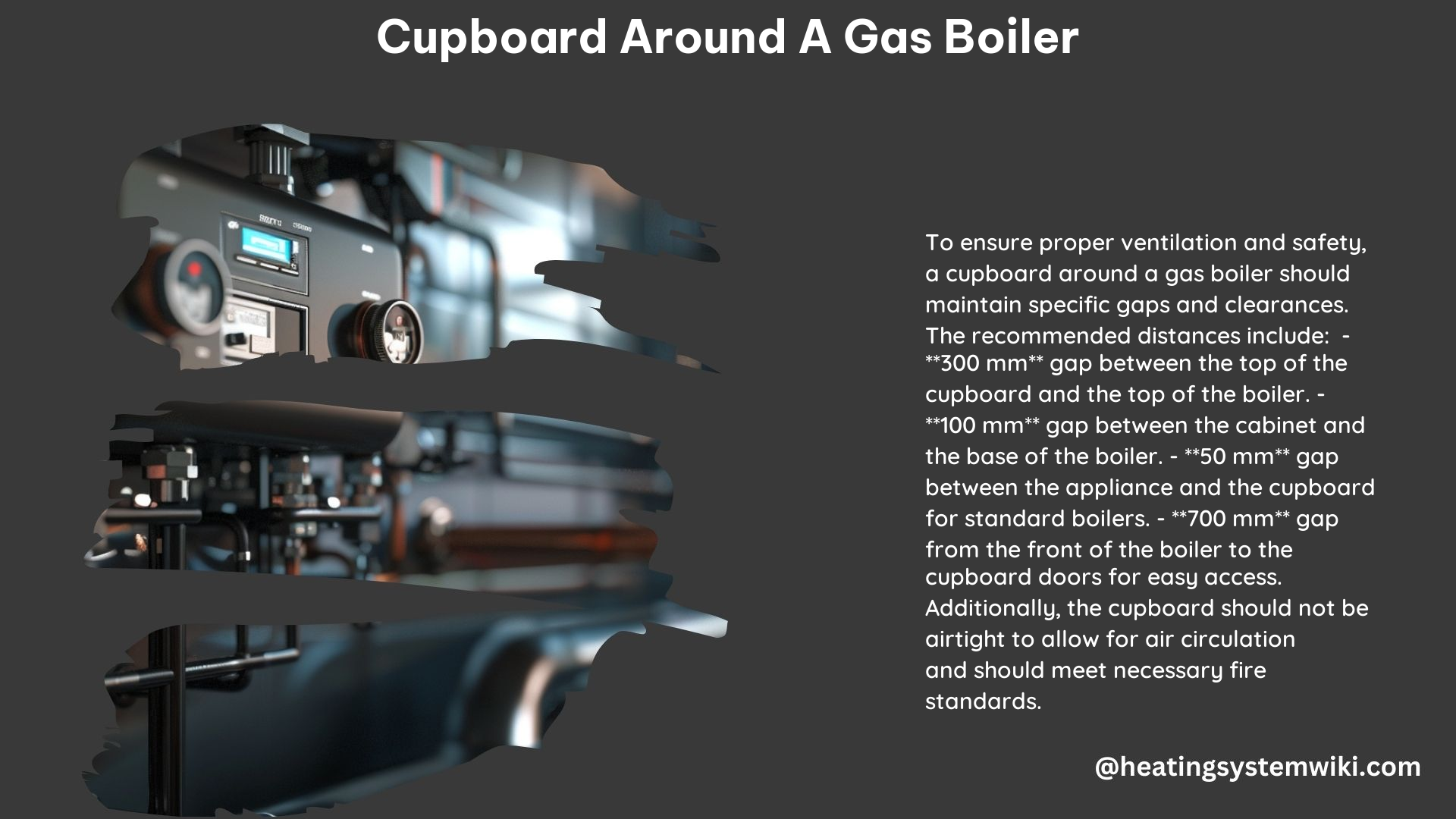Hiding a gas boiler in a kitchen or utility room can enhance the aesthetic appeal of the space while ensuring safety and functionality. This comprehensive guide delves into the key considerations and technical specifications for building a cupboard around a gas boiler, providing homeowners with a detailed roadmap for a successful DIY project.
Safety Regulations: Prioritizing Ventilation, Accessibility, and Fire Standards
Ventilation Requirements
Proper ventilation is crucial for the safe operation of a gas boiler. Ensure a minimum gap of 50 mm between the boiler and the cupboard walls to allow for adequate combustion and cooling air circulation. This gap ensures that the boiler receives the necessary airflow, preventing potential overheating and ensuring efficient combustion.
Accessibility for Maintenance and Repairs
The gas boiler must be fully accessible for servicing, maintenance, and repairs. The cupboard should have a door that can open easily, providing unobstructed access to the boiler. This accessibility is not only a safety requirement but also ensures the longevity and optimal performance of the heating system.
Compliance with Fire Safety Standards
The cupboard housing the gas boiler must meet the necessary fire safety standards to prevent any potential fire hazards. This may involve the use of fire-resistant materials, the installation of fire-rated doors, and the incorporation of appropriate ventilation systems to mitigate the risk of fire.
Minimum Dimensional Requirements: Ensuring Proper Clearances

Gap Above the Boiler
Maintain a minimum gap of 300 mm between the top of the cupboard and the top of the gas boiler. This clearance allows for easy access to the boiler’s controls and ensures that the heat generated by the unit can dissipate effectively.
Gap Below the Boiler
Provide a minimum gap of 100 mm between the base of the cupboard and the base of the gas boiler. This clearance ensures that the boiler’s air intake and any necessary drainage or pipework are not obstructed.
Gap in Front of the Boiler
Maintain a gap of at least 700 mm between the front of the gas boiler and the cupboard doors. This generous clearance allows for the easy removal and replacement of the boiler’s front panel, facilitating maintenance and servicing tasks.
DIY Installation: Measuring, Cutting, and Ventilating
Measuring and Cutting the Cabinets
Carefully measure the dimensions of the gas boiler and the available space in the kitchen or utility room. Cut the cabinet to fit the space, ensuring that the necessary clearances are maintained around the boiler.
Using Heat-Resistant Materials
Select heat-resistant materials for the cabinet and any paint or finishes to prevent damage from the boiler’s heat. Avoid using materials that may degrade or become a fire hazard when exposed to high temperatures.
Adding Ventilation Holes
Drill ventilation holes in the roof and sides of the cupboard to ensure proper airflow and prevent the buildup of heat. These strategically placed holes allow the boiler to receive the necessary combustion and cooling air, maintaining its efficient and safe operation.
Choosing the Right Boiler: Compact, Efficient, and Quiet
Compact Boiler Models
Consider compact boiler models that are designed to fit within a standard kitchen cupboard, such as the Viessmann Vitodens 050-w and the Ideal Logic C30. These space-saving units can be seamlessly integrated into the cupboard, minimizing the visual impact on the overall kitchen or utility room design.
Efficiency and Noise Considerations
When selecting the gas boiler, prioritize models that are highly efficient and operate quietly. Efficient boilers not only save on energy costs but also generate less heat, reducing the risk of overheating within the confined cupboard space. Additionally, quiet boiler operation ensures minimal disturbance to the household.
Additional Tips: Customizing and Enhancing the Cupboard
Painting the Boiler
Paint the gas boiler to match the surrounding decor, ensuring that the paint used is heat-resistant and can withstand the high temperatures generated by the unit.
Boiler Curtains
Consider using a boiler curtain as a less invasive and more cost-effective solution for concealing the gas boiler. Boiler curtains can be easily installed and provide a decorative cover for the unit.
Utilizing Storage Cupboards
Explore the option of using a storage cupboard to house the gas boiler. This approach not only hides the boiler but also provides additional storage space, making the most of the available area.
By following the guidelines and technical specifications outlined in this comprehensive guide, homeowners can successfully and safely conceal their gas boilers within a custom-built cupboard, enhancing the overall aesthetic of their kitchen or utility room while ensuring the proper functioning and maintenance of their heating system.
References:
- Boiler Central. (n.d.). Hiding A Boiler – Can You Put A Boiler In A Kitchen Cupboard? Retrieved from https://www.boilercentral.com/boiler-advice/hiding-a-boiler/
- Real Homes. (2021, December 8). How to box in a boiler using IKEA’s SEKTION cabinet. Retrieved from https://www.realhomes.com/advice/how-to-box-in-a-boiler
- Viessmann UK. (2022, March 24). How to Hide a Boiler in the Kitchen. Retrieved from https://www.viessmann.co.uk/en/heating-advice/boilers/how-to-hide-a-boiler-in-a-kitchen.html
- DIYnot Forums. (2008, June 12). Cupboard around a boiler. Retrieved from https://www.diynot.com/diy/threads/cupboard-around-a-boiler.138424/
